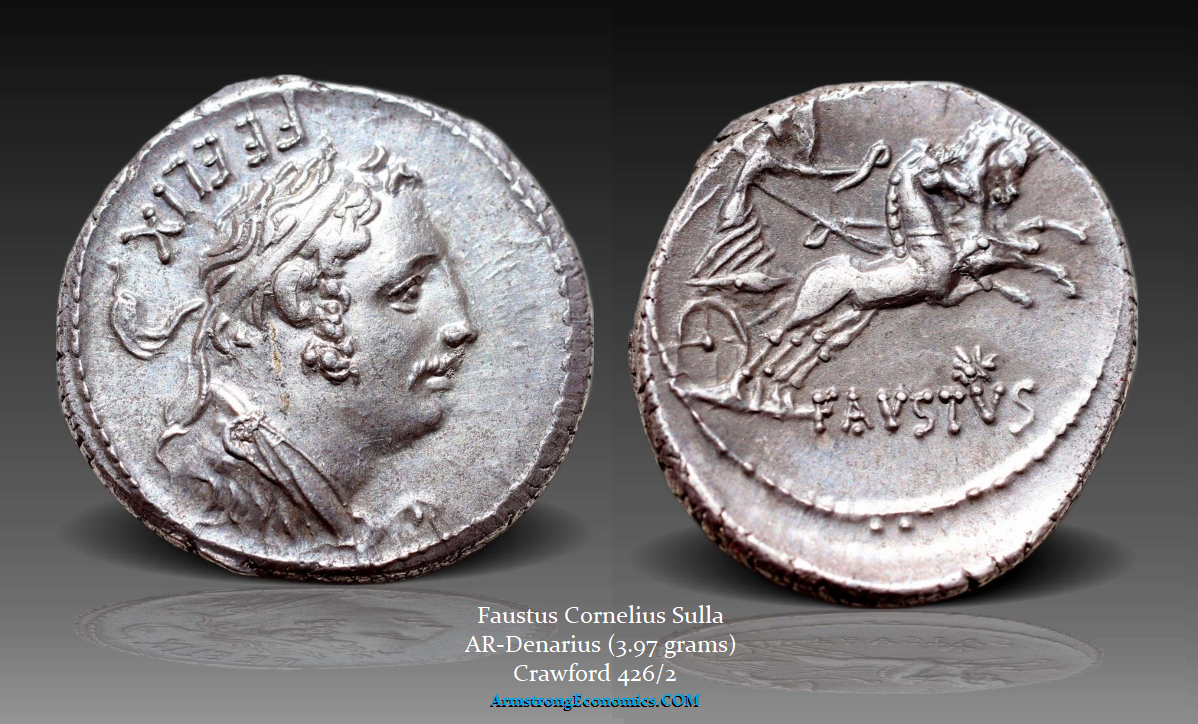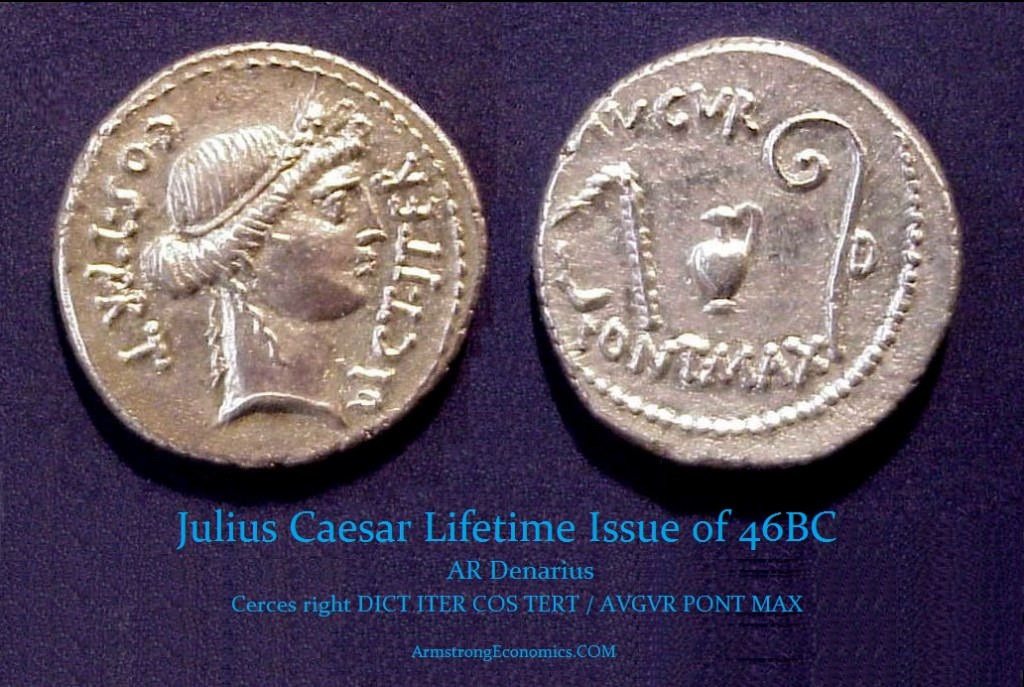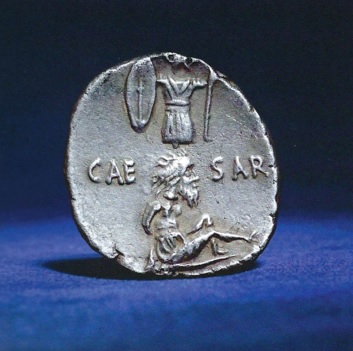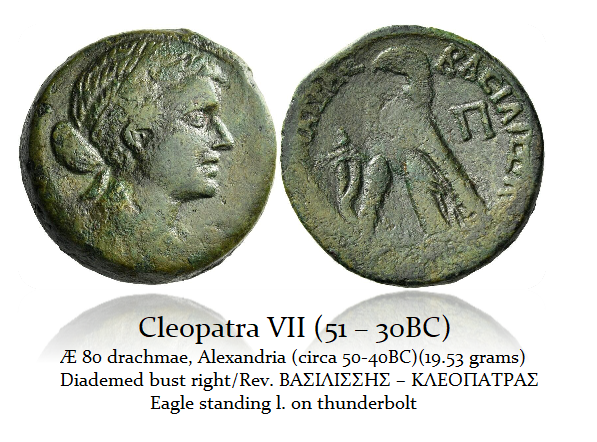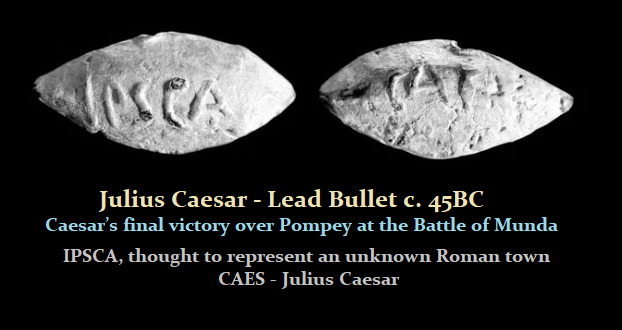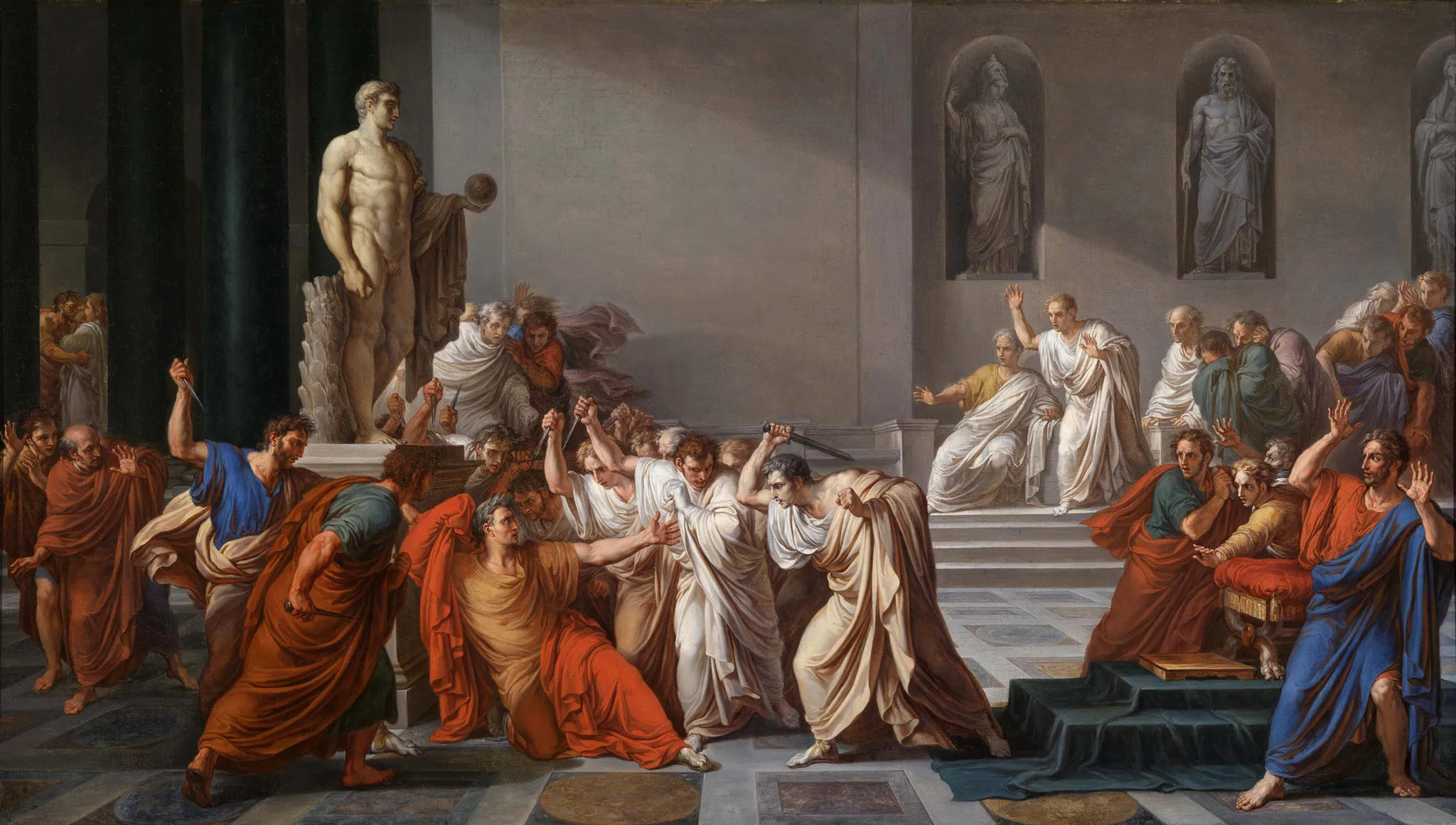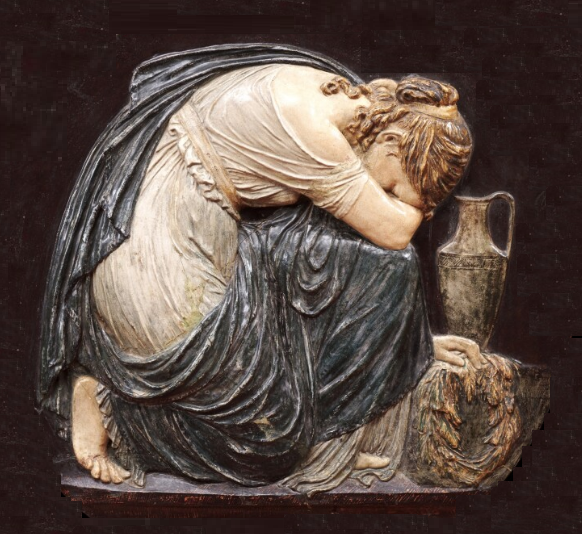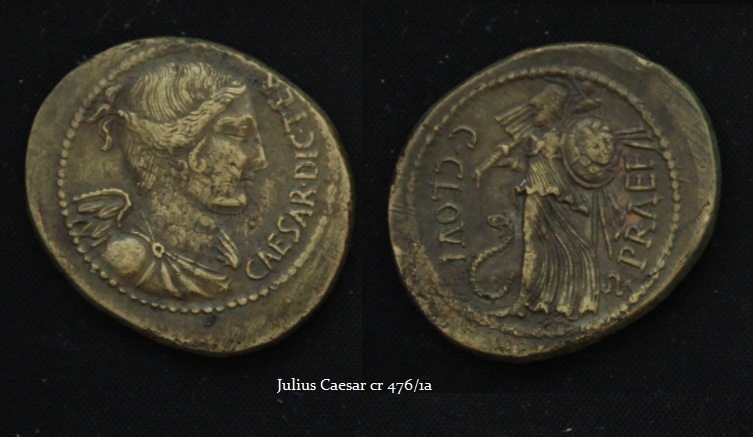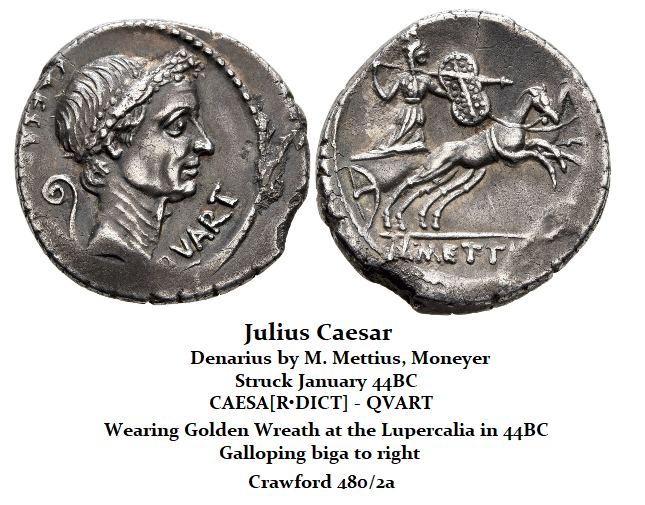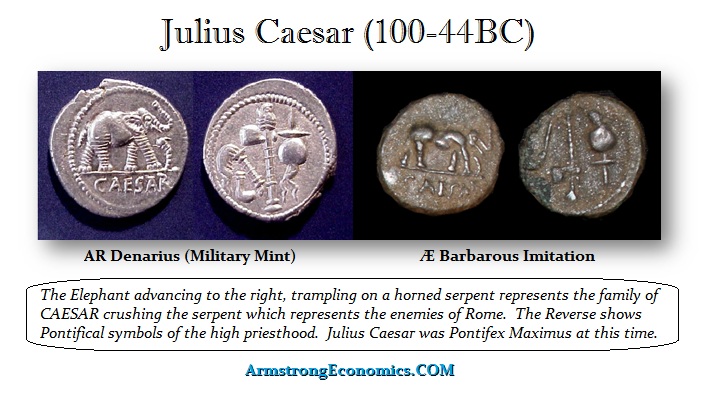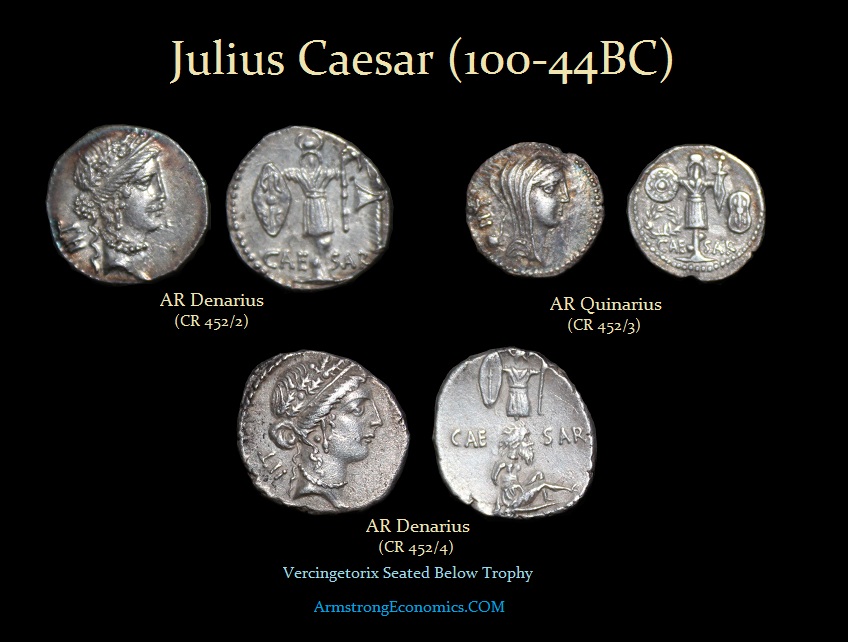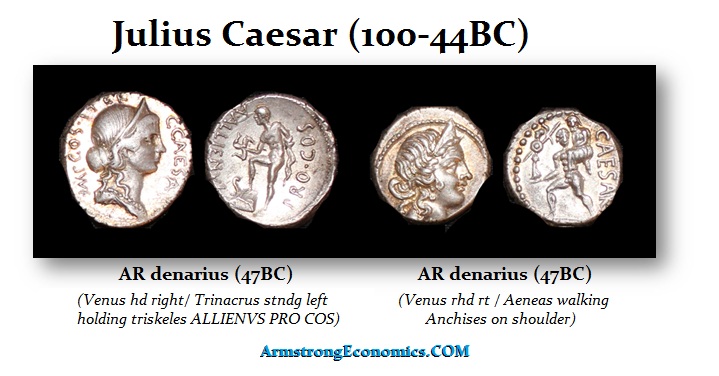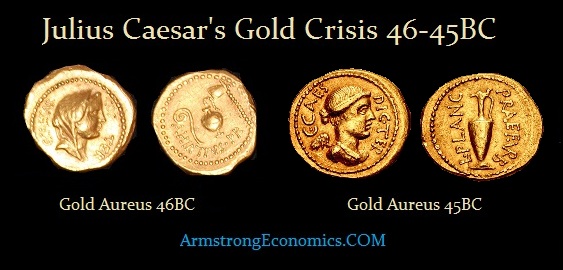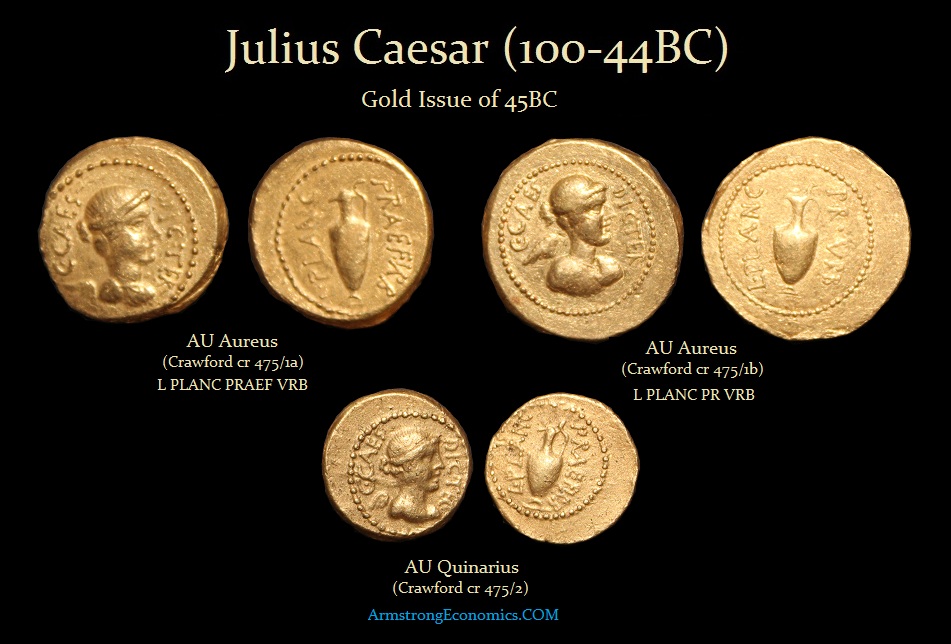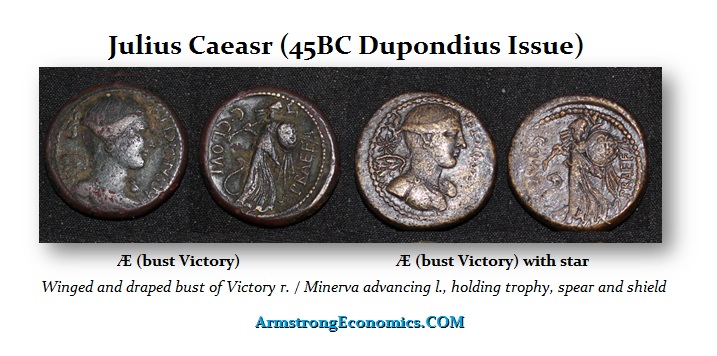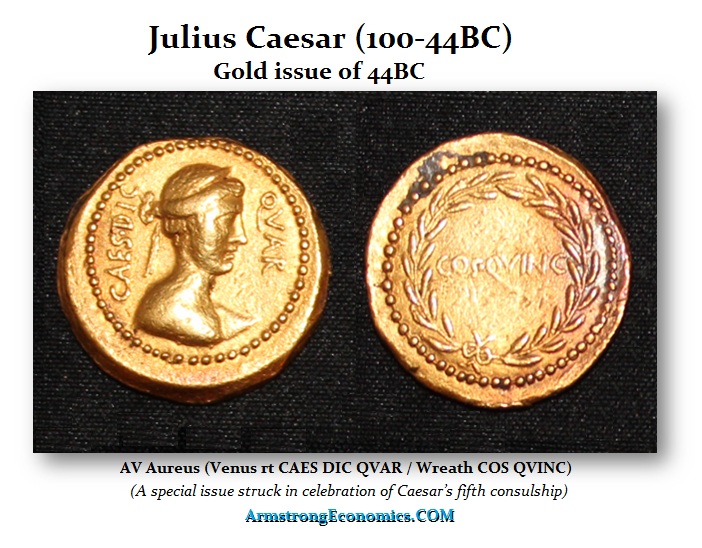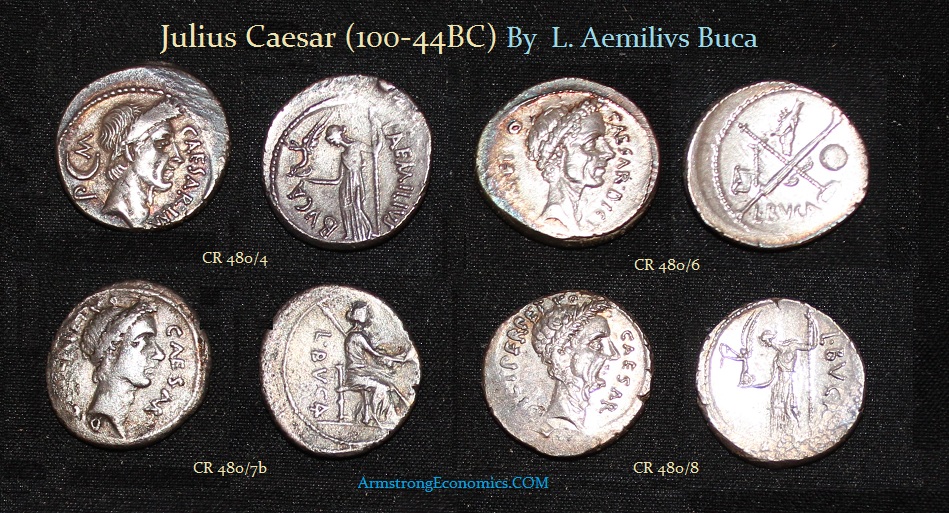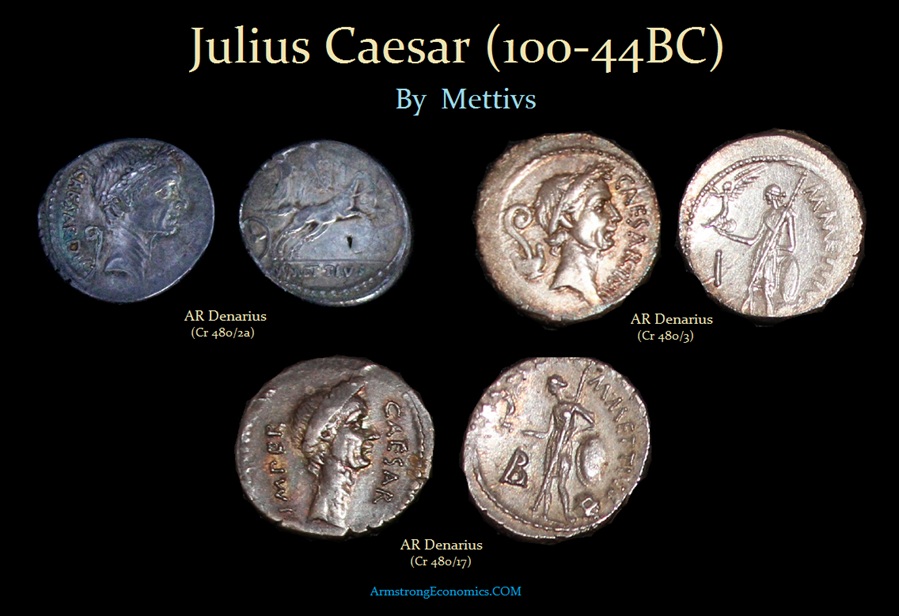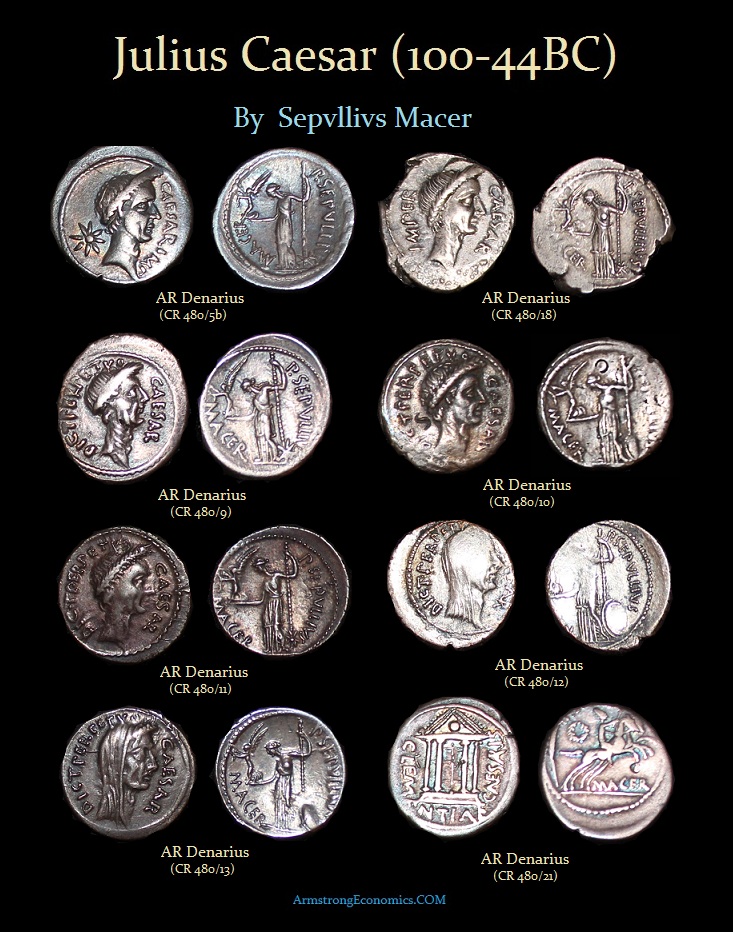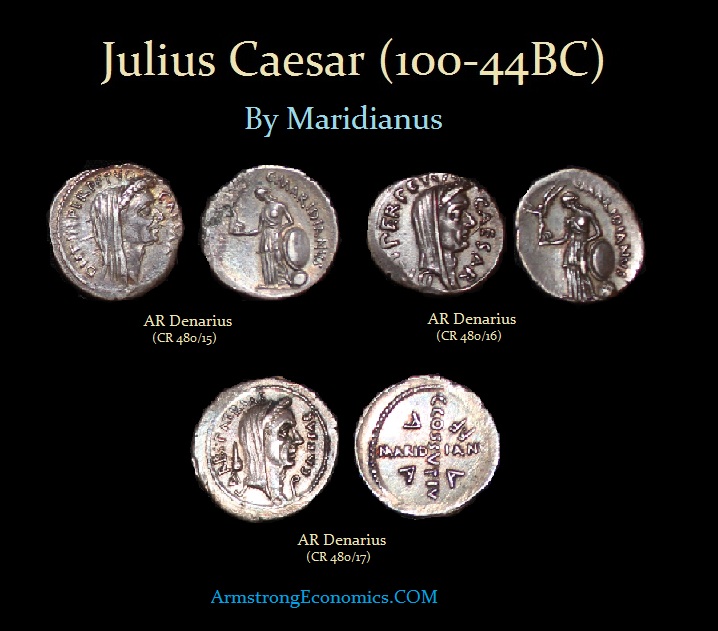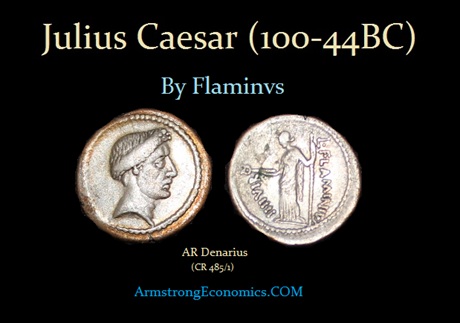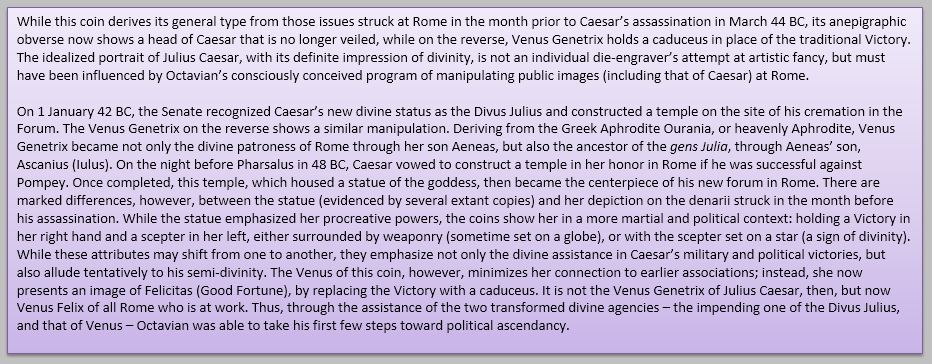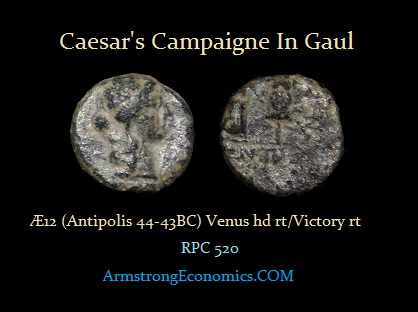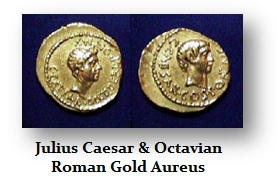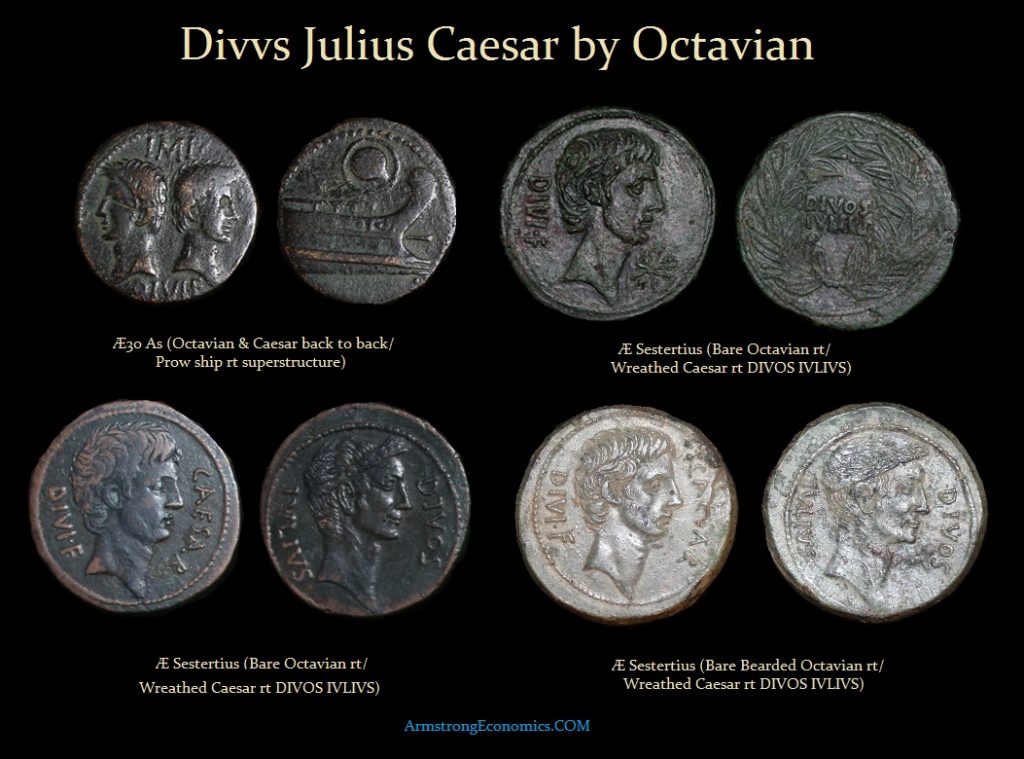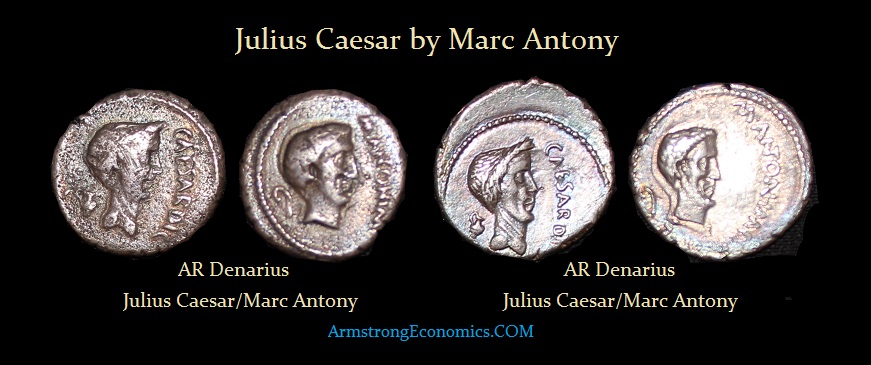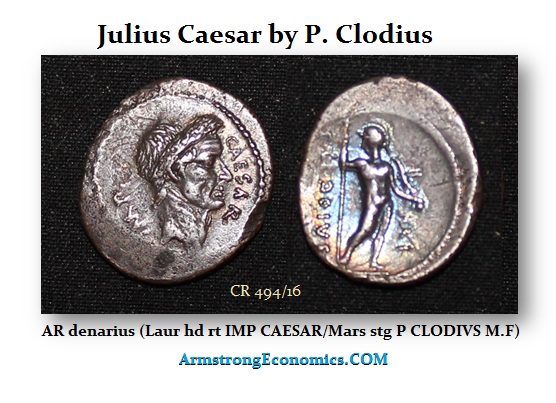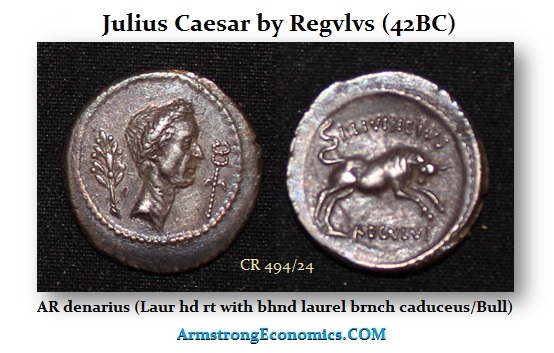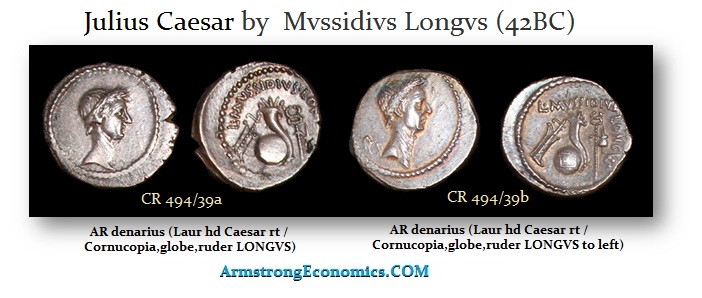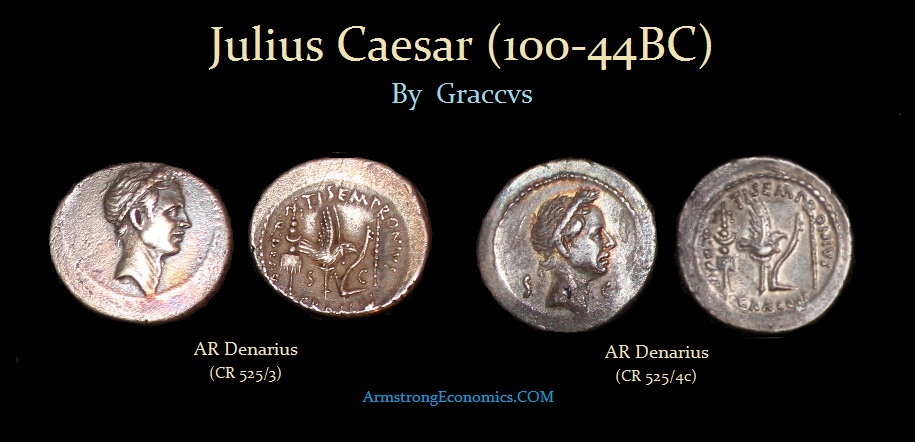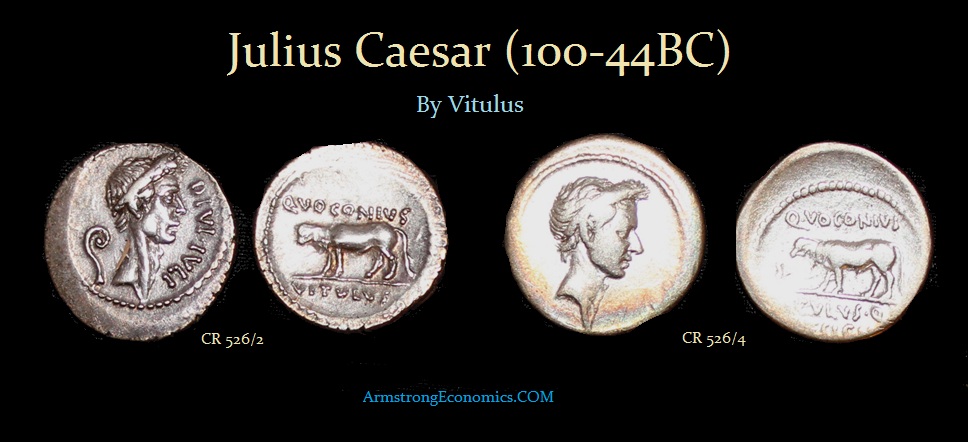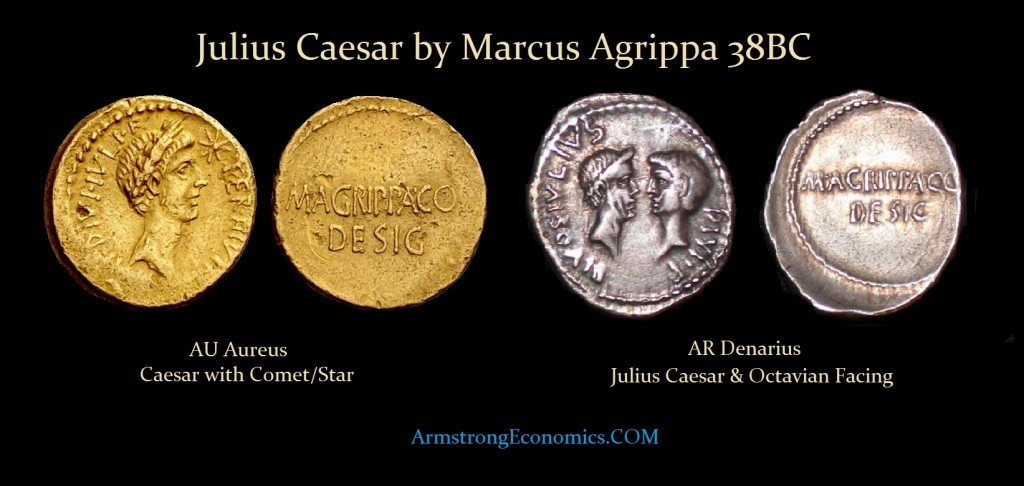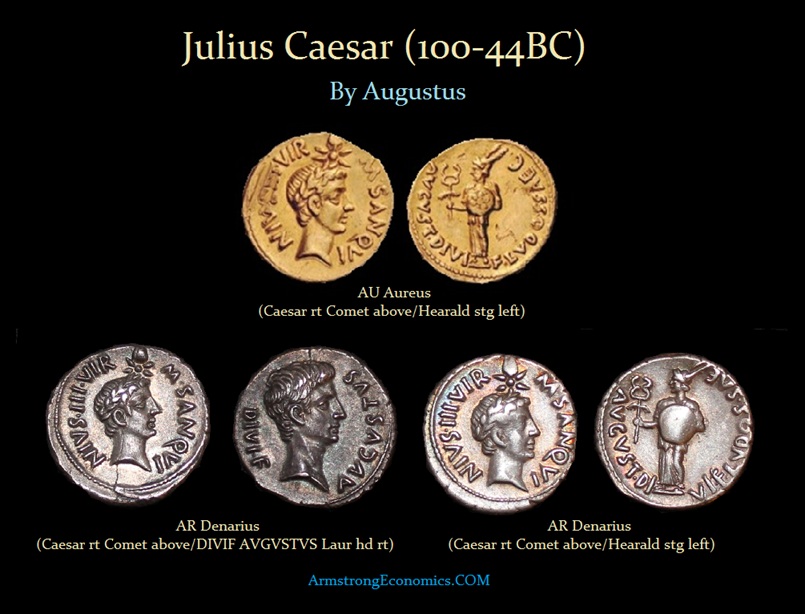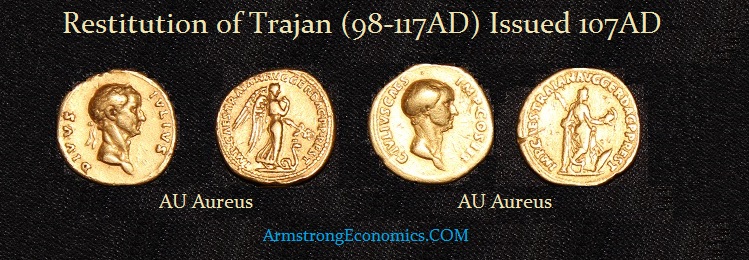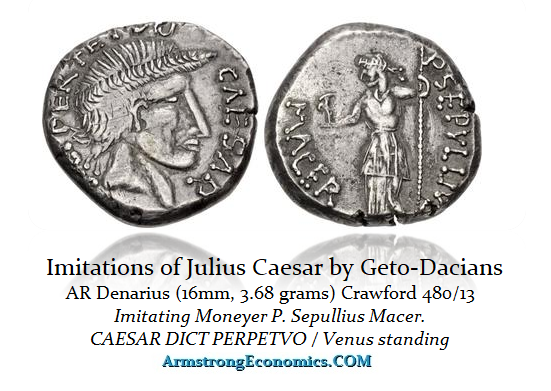Dictator, 48 – 44 BC
Born 100 BC – Assassinated 44 BC, age 56
Temple of Alexandria & the Black Bust of Caesar
Gaius Julius Caesar was born to an aristocratic family. His parents were Gaius Julius Caesar and Aurelia. Julius was born on July 13th, 100 BC, for whom the month of July is named. During the early years of his career, Caesar identified himself politically with the Populares Party (See Marius), which opposed the Senatorial nobility. His political views, therefore, cast him as a political enemy of the dictator Sulla, which became clear when he married Cornelia. Only with the aid of influential friends was Caesar able to escape Sulla’s reign of terror (83 – 82 BC) by fleeing to Rhodes. Caesar used the time in exile to study oratory. He also used his time in Rhodes to gain military experience along the Eastern Mediterranean.
Following the death of Sulla in 78 BC, Caesar returned to rejoin the few remaining supporters of government reform. He began rebuilding relationships aimed at forming a foundation for possible future power. When Pompey and Crassus received their Consulships in 70 BC, most of Sulla’s laws were abrogated. In 69 BC, Caesar managed to be assigned as Quaestor in Spain and then in 65 BC was appointed Aedile (an official in charge of buildings, etc.). He received the coveted Pontifex Maximus (Chief Priest of the Gods) in 63 BC.
Caesar was suspected of having secret knowledge of a conspiracy centered around Lucius Sergius Catalina involving a plan for the burning of Rome and the murder of many of the Chief Magistrates. Crassus was also suspected of being involved. Catalina was killed by Metellus Celer and Gaius Antonius, after many of Catalina’s followers had been arrested and executed. Somehow, Caesar (and Crassus) managed to disassociate themselves from the conspiracy. Despite the suspicion of Caesar’s possible prior knowledge of the so-called “Catiline Conspiracy,” Caesar managed to be elected Praetor (Magistrate, the office just below Consul) in 62 BC, in which he served with distinction.
His major political achievement, however, was the formation of the “First Triumvirate” with Pompey and Crassus, whereby he associated himself with the two most powerful politicians and military men of the day. Caesar, as part of the agreement, became Consul in 59 BC and received a commission to go to Illyricum and Cisalpine and Transalpine Gaul as Governor for a period of five years, a term later extended to ten years. In order to strengthen the political bonds with Pompey, Caesar also gave his daughter Julia in marriage to Pompey in 59 BC. Julia proved to be an important influence on both men, often forcing them to settle their differences and compromise.
 Unfortunately, Julia died in 54 BC, and with her went the one true mediator between Pompey and Caesar. Caesar’s military exploits in the West had rivaled those of Pompey’s in the East. Caesar was able to add all of Gaul’s Expeditions between the Rhine River and the Pyrenees Mountains to the Roman Empire. This was in addition to two “Warning Expeditions” which he had made to the coast of Britain. Caesar’s military accomplishments, together with the death of his daughter, Julia, and the death of Crassus a year later in 53 BC, allowed the two to drift further apart politically.
Unfortunately, Julia died in 54 BC, and with her went the one true mediator between Pompey and Caesar. Caesar’s military exploits in the West had rivaled those of Pompey’s in the East. Caesar was able to add all of Gaul’s Expeditions between the Rhine River and the Pyrenees Mountains to the Roman Empire. This was in addition to two “Warning Expeditions” which he had made to the coast of Britain. Caesar’s military accomplishments, together with the death of his daughter, Julia, and the death of Crassus a year later in 53 BC, allowed the two to drift further apart politically.
Pompey proved to be easily influenced by the corrupt Senate of Rome, which was primarily interested in retaining their old boy’s network of privileged status and trade monopolies. Corruption in the Senate became outrageous towards this point in history. Elections were routinely fixed, and no one other than the privileged few could even run for office. The corruption had escalated to the point that the calendar had been altered so many times in order to extend the various factions’ terms of office that summer took place where winter once ruled.
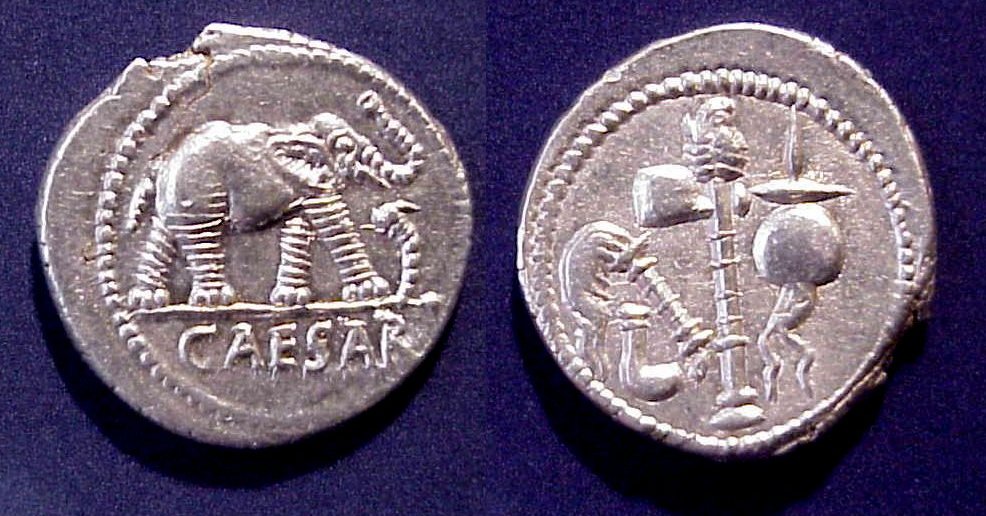
The rising popularity of Caesar as a man of the people threatened the Senate’s future, and they knew it. The corrupt Senate exploited Pompey for their own devices and attempted to strip Caesar of all power, ultimately forcing a civil war between the two former associates. Caesar marched into Italy, and when he crossed the Rubicon, he remarked: “The is cast.” This is his Rubicon coinage with the elephant trampling the corrupt Senate. The reverse reflects the instruments of Pontiff Maximus. Note that this coin only bears his name, for traditionally, it would have the name of the moneyer or treasurer. Using his own name was a magnanimous gesture for he did not want anyone else to have to accept responsibility for coinage issued to march on Rome.
Caesar soundly defeated Pompey’s army at Pharsalus in Thessaly on August 9th, 48 BC. Pompey fled from Rome, as did many members of the Senate. Pompey fled to Egypt, where he was beheaded. When Caesar arrived in Egypt, he was presented with Pompey’s head.
It was during this trip to Egypt that Caesar first met Cleopatra VII, the eldest daughter of Ptolemy Auletes, King of Egypt. Pompey had been murdered by her brother, Ptolemy, which greatly displeased him, to say the least. Caesar then arbitrated the dispute between Cleopatra and her brother for the throne, ruling against Ptolemy, who gathered his forces and attempted to destroy Caesar’s legions. In the ensuing battle, the Great Library of Alexandria was burned. Ptolemy was defeated, and Caesar installed Cleopatra on the throne.
In the time that passed, Caesar became intimately involved with Cleopatra, and it is believed that they may have had a son named Ptolemy Caesarion. When Caesar left Egypt, Cleopatra ascended to the throne of Egypt, sharing it with her younger brothers, Ptolemy XIII and XIV.
Caesar spent the next two years defeating the remnants of Pompey’s Senatorial armies at Thapsus in Northern Africa in 46 BC and at Munda in Spain on March 17th, 45 BC, where Pompey’s two sons, Caenus and Sextus, barely escaped with their lives.
Finally, Caesar conducted a swift five-day campaign, defeating Pharnaces II of Pontus and producing Caesar’s famous boast “Veni, Vidi, Vici” (I came, I saw, I conquered).

Silver Denarius with a portrait of Caesar
Caesar was now the undisputed ruler of the Greco-Roman world, and he set about a major political and economic reform project. While much of what has been written about Caesar is an attempt to portray him as a ruthless dictator, the evidence does not support the bias of many contemporary writers. It must be kept in mind that the Senate of Rome had been dominated by aristocratic families seeking special business concessions or monopolies in trade. The entire process of the once-great Roman Republic had become very corrupt prior to the Civil War. Economic conditions had declined severely, and the economy was in a serious recession. Real estate values had plummeted, and lenders refused to accept property in return. We must also keep in mind that the majority of the moneylenders were none other than the Senators themselves. In the context of this atmosphere, Caesar proposed to rule as a Dictator. His actions, though, were always intended to better Roman citizens’ lives.
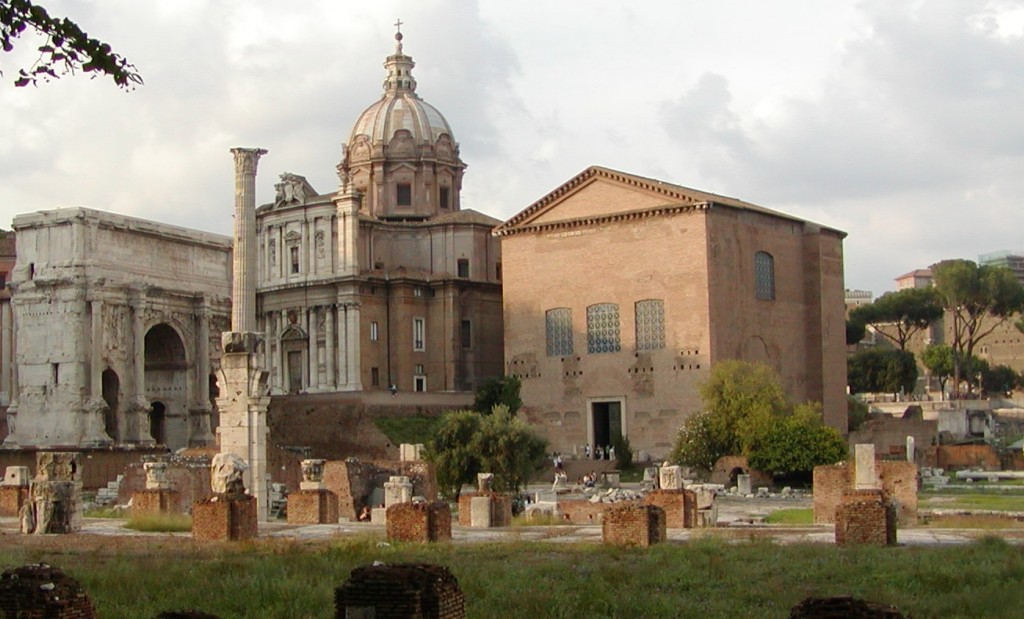
Curia Julia
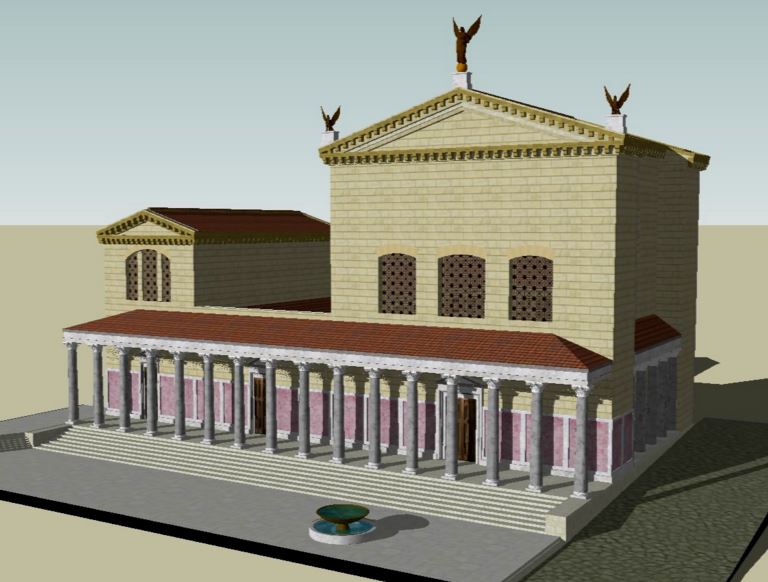
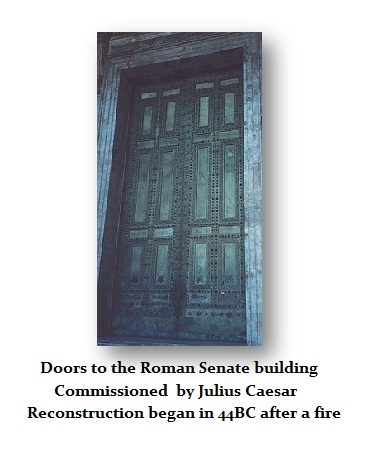 Again, some will argue that Caesar expanded the Senate of Rome to dilute its authority. However, this expansion of the Senate, including the building of the Curia, could also be interpreted as an act to break the monopolies within the Senate. The benefit would logically produce a better, more representative form of government. The new Curia was built in the heart of the Roman Forum, which still stands today. The bronze doors, personally commissioned by Caesar, are still in use today at the Church of Saint Lateran in Rome.
Again, some will argue that Caesar expanded the Senate of Rome to dilute its authority. However, this expansion of the Senate, including the building of the Curia, could also be interpreted as an act to break the monopolies within the Senate. The benefit would logically produce a better, more representative form of government. The new Curia was built in the heart of the Roman Forum, which still stands today. The bronze doors, personally commissioned by Caesar, are still in use today at the Church of Saint Lateran in Rome.
Caesar’s legal reforms were simply brilliant. He regulated and systematized municipal government throughout Italy and introduced social and economic reforms, including a drastic reduction of the number receiving the dole of grain (modern-day welfare reform). He also established the annual interest rate at no higher than 12%, ending loan sharking, which had devastated the lower classes. Caesar also completely reformed the old Roman calendar into a scientific one based upon astronomical calculations that, for the first time, included the concept of Leap Year. His efforts in this regard led to the development of the “Julian” calendar. In the field of commerce, Caesar planned the construction of a major canal through the Isthmus of Corinth and a codification of the current existing rule of Roman Law.
One can only imagine how, even in our modern democratic societies, the corruption and self-interest of the various political parties and individuals sometimes bring progress to a halt through sheer gridlock. With widespread corruption and the great injustices against the common man left uncorrected, even after the Social Wars of 90 – 89 BC, the atmosphere within the Senate of Rome must have been fully charged in light of Caesar’s reforms.
Indeed, Caesar’s ambitious reform program threatened the very institutions of the Republic, not for the sake of the common man, but from the viewpoint of the self-interest of the corrupt Senate. Their thin veil of a pretense of caring for the state was at last lifted, and what was suddenly revealed for all to see was a corrupt network of control and deceit for personal gain. Within such an atmosphere, Caesar dared to hold true to his beliefs of a free society void of aristocratic control. A new republic was Caesar’s goal, one in which elections would be legitimate and corruption tempered and controlled. That could only be accomplished at this late stage in Republican history by a benevolent dictator who the people would trust. Caesar was that man. He did not attempt to abolish the Senate or the election process. There were no attempts to establish a kingdom in Eastern traditions.
The reform program of Caesar came to a sudden end with his assassination led by Gaius Cassius, the first of 23 senators to stab him, and Marcus Brutus was the last on the Ides (15th) of March 44 BC. In this last desperate act, the noble Caesar fell at the hands of the corrupt Senatorial oligarchy. The assassins of Caesar tried to paint their deed in the shining light of liberty. However, Caesar’s reforms were not self-serving and always placed the good of the Roman people above that of their corrupt Senate.
Following Caesar’s assassination, Marc Antony immediately took possession of Caesar’s papers and residence, including whatever assets he had held. Antony then gave his famous funeral oration in the Forum standing traditionally upon the Rostra of Rome. There, Antony delivered his impassioned speech, which proved to be instrumental in turning the people against the corrupt Senators who, by now, had become mere assassins.
Shortly before his death, Caesar had written a will in which he adopted as his son his great-nephew Gaius Octavius, grandson by his stepsister Julia. Octavian, at the time, was relatively young, though a prominent member of Caesar’s entourage. By the stroke of fate, Octavian would later become Rome’s first Emperor known to history as Augustus. As for the assassins, Marc Antony and Octavian chased them down and had them all put to death.
Monetary System
Æ Dupondius Winged Victory
Caesar minted coins without the permission of an official Roman moneyer. Without any legitimate source of materials for coinage, he ransacked the state reserves in the basement of the Temple of Saturn. Pliny the Elder recounts that he made off with 15,000 ingots of gold, 30,000 ingots of silver, and what may have been the equivalent of 7.5 million silver denarii worth of coinage.
Lifetime Issues
Mints: Rome, military moving mint
Obverse Legends:
CAESAR (49-45 BC)
C CAESAR COS TER (46 BC)
C CAES DIC TER (45 BC)
CAES DIC QVAR (44 BC)
CAES DIC QVART (44 BC)
CAESAR IMP (44 BC)
CAESAR DICT PERPETVO (44 BC)
CAESAR DICT IN PERPETVO (44 BC)
DENOMINATIONS
AU Aureus (6.54 grams)
AU Quinarius (3.54 grams)
AR Denarius (3.54 grams)
AR Quinarius (1.58 grams)
Æ Dupondius (Winged Victory)
(Silver content average 96.8%)
LIFETIME ISSUES
AU Aureus (Open hand lf/Victory on a globe) by SCARVS.IMP
Without Portrait
49 BC
AR denarius (Elephant/Priest emblems) Moving Mint
—– AS ABOVE (AE Barbarous Imitation)
48 BC
AU Female r / Trophy w/Gallic shield CAESAR below 9 Known
AR den (Female /Gallic shield CAESAR below)
AR Quinarius (Veiled Vesta rt /Trophy) Ex Benz
AR den (Female /Trophy bearded captive)
———- as above /captive looking up
47 BC
AU Axe Culullus “CAESAR” reads down/Jug Lituus 13 known
——— as above “CAESAR” read upward
AR denarius (Venus rt/Stg left ALLIENVS PRO COS)
AR den Venus r / Aeneas walking Anchises on the shoulder
Caesar returned to Rome in 46 BC and began such a sweeping economic reform that it puts to shame any pretended accomplishments of the first 100 days that began with Roosevelt. Due to the civil war, the natural human response was to hoard money. Commerce declined, and the debt crisis loomed. The second Aureus of 45 BC commemorated the final victory over all his enemies. We now find a dramatic increase in the money supply, which was, in reality, a form of Quantitative Easing but with a direct increase in the quantity of money in circulation.
46 BC
AU Veiled Female / Lituus Jug & ax
———as above COS_TER
———as above COSTER
———as above COS.TER
AR denarius (Ceres r COS TERT DICT ITER/Culullus,jug litiuus) “D” to rt
———– as above /”M” on right
AR denarius (Venus rt, cupid/Trophy 2 captives CAESAR)
AR denarius (Venus lft, cupid/Trophy 2 cap, 1 kneeling)
45 BC
AU Victory C CAES DIC TER / Jug L PLANC PRAEF VRB
———as above / PR VRB
AU Quinarius (1/2 Aureus) as above
Æ Dupondius (bust Victory)
Æ Dupondius (bust Victory)with star
AU Venus r CAES DIC QVAR / Wreath COS QVINC
AR den (Venus r / Trophy Lf Chariot r shield C.CAESAR)
——- as above / variety CAESAR no C.
Julius Caesar Portraits
BY L. AEMILIVS BUCA 44 BC
AR den (Caesar bhd Crescent/Venus hldg vic & scepter)
AR den (Caesar / Fasces,caduces clasped hnds L.BVCA)
AR den (Caesar/Venus seated r L.BVCA) Venus Seated
———-similar DICT PERPETVO CAESAR/ Venus seated
———-similar DICT PERPETVO CAESAR/ Venus stg left
BY METTIVS 44 BC
AR den (Caesar r litus curved lf behd / biga)
———–as above /M.METTIUS below biga not exq
———–as above, but litus curved rt behind Caesar
AR den (Caesar r litus, culullus bhnd/Venus stg shld globe)
———- CAESAR IM
AR Den (Wrthd Caesar rt CAESAR-IMPER/Vic shld/globe)
AR Den (Wrthd Caesar rt/Vic shld,globe “B” in field)
BY SEPVLLIVS MACER 44 BC
AR den (Caesar bhnd star / Venus stg lf MACER upwards)
———–similar /star at btm of scepter MACER upwards
———–as above / Venus lft victory,scepter,shield MACER
——–similar 7b /Vic stg lf P SERVLLIVS – MACER upwards
———similar MACER dwn star at base of scepter
AR den (Veiled hd r DIC PERPETVO/Venus stg lft as 9)
——-as above / Venus lft, vic,scepter,shld MACER dwn
——- as 12 DICT PERPETVO / as 11
—— as 17 wreathed / as 11 Ex Benz
—— as 19 / Desultor r bhnd palm branch & wreath MACER
AR Den Temple CLEMENTIAE CAESARIS/Rearing horses MACER
BY MARIDIANUS 44 BC
AR Den (V hd rt DICT IN PERPETVO/Venus Lf C.MARIDIANVS)
AR Den (V hd rt DICT PERPETVO/Venus Lf C.MARIDIANVS)
AR Den (V+Wrthd rt apex-litus/C.COSSVTIVS.MARIDIANVS)
BY FLAMINVS 44 BC
AR Den (Laur hd rt no leg/Vic secpter L.FLAMINIVS)
AR Den (Laur hd rt no leg/Biga)
Colonial Lifetime Issues
(COLONIAL) LIFETIME ISSUES
AE23 (CORINTH) Laur hd Caesar rt/Pegasus rt
AE25 (NICAEA) Bare hd Caesar rt/Nike rt [by C.Vibius Pansa]
AE22 (LAMPSACUS Asia) Laur hd Caesar rt/Oxen rt
AE22 (LAMPSACUS Asia) Laur hd Caesar rt/Oxen rt
AE19 (LAMPSACUS Asia) female rt wreath corn/female stg
AE19 (LAMPSACUS Asia) female rt wreath corn/female stg
AE16 (LAMPSACUS Asia) Janus head/prow rt
AE16 (LAMPSACUS Asia) Janus head/prow rt
(COLONIAL) CAESAR’S CAMPAIGNE IN GAUL
AE12 (Nemausus 40BC) Helmeted Roma rt/Hygeia standing lf
AE12 (Antipolis 44-43BC) Venus hd rt/Victory rt
Posthumous Coinage of
Julius Caesar
Gold Aureus Caesar & Octavian
Due to the political climate following the assassination of Caesar, the coinage reflected very much the need for propaganda on both sides. The supporters of Caesar often displayed their own portrait on the reverse of many issues, thus trying to invoke the love and loyalty that the people had felt for Caesar in their own cause. Likewise, the assassins usually displayed a bust of liberty, trying to argue that they were for the Republic despite the fact that the Republic had become so corrupt and the Senate merely a gathering place for the old boys to divide the spoils.
In the case of Caesar, his portrait appears in conjunction with Octavian and Marc Antony. However, his portrait appears on several issues of other supporters who simply inscribed their name on the coinage and not their own portrait.
Obverse Legends:
CAESAR IMPER (44 BC)
CAESAR PATRIAE (44 BC)
CLEMENTIAE CAESARIS (44 BC)
CAESAR IMP (42 BC)
Denominations Issued:
AU Gold Aureus
AU Gold Quinarius
AR Silver Denarius
AR Silver Quinarius
AE Dupondius
Colonial Postumus Issues
BY OCTAVIAN
AE20 (DYME Achaea) Diademed Hd rt/plough
AE20 (DYME Achaea) Diademed Hd rt/bare Octavian rt
AE25 (SINOPE Bithynia) Laur Hd Caesar rt/clasped hands
BY MARC ANTONY 43 BC
AR den M Antony / Caesar
AR den M Antony (M.ANTON.IMP.RPC)/Caesar
BY CLODIUS 42 BC
AU Aureus (Laur hd rt/Mars “P.CLODIVS”) 42BC
AR den (Laur hd rt IMP CAESAR/Mars stg P CLODIVS M.F)
BY REGVLVS 42 BC
AR den (Laur hd rt with behind laurel branch caduceus/Bull)
BY MVSSIDIVS LONGVS 42 BC
AR den (Laur hd rt/Cornucopia,globe,ruder LONGVS)
AR den (Laur hd rt/as above LONGVS to left)
BY GRACCVS 40 BC
AR den (Laur hd rt/vexilum,aquila,plough GRACCVS)
—— as above SC / as above no SC on rev
—— as above SC / as above GRACCVS Q.DESI
—— as above SC / as above GRACCVS Q.DES Ex Benz
BY VITULUS 40 BC
AU Aureus (Lr hd rt litus behnd DIVI IVLI/Calf VITVLVS)
AR den (Laur Caesar litus behnd DIVI IVLI/Calf VITVLVS)
—— as above / Calf + S C DESIGN
BY SCARPUS 40 BC
AU Aureus (Open hand lf/Victory on globe)
AR Denarius (Open hand lf/Vic on globe rt)
AR Quinarius (Open hand lf/Vic on globe rt)
by Marcus Agrippa 38BC:
AU Gold Aureus (Laur hd rt/”M.AGRIPPA.COS”)
AR Silver Denarius (Caesar+Octavian facing/M AGRIPPA COS DESIG)
by Augustus:
AR den Caesar hd rt comet above/priest stg left
AR den (Caesar rt Comet above/DIVIF AVGVSTVS)
AR den (Caesar rt Comet above/DIVIF AVGVSTVS Laur hd rt)
AR den (Caesar rt Comet above/Herald stg left shield)
Colonial Postumus Issues
BY AUGUSTUS
AE As (Rv Augustus) Spanish Mint UNLISTED
AE35 (ACHULLA Africa) Bare Hd lf/bare Augustus rt
AE24 (APAMEA Bithynia) Dia. Caesar Hd rt/Laur Augustus rt
AE23 (APAMEA Bithynia) bare Caesar Hd rt/bare Augustus rt
AE25 (AEGEAE Syria) Diademed Hd rt Alexander Great/Caesar rt
AE23 (CORINTH Achaea) Laur hd Caesar rt/bare Augustus rt
AE20 (CORINTH Achaea) Laur hd Caesar rt/bare Augustus rt
AE35 (HADRUMETUM Africa) Bare Hd rt/Bare hd Augustus rt
AE30 (HADRUMETUM Africa) Bare Hd rt/Bare hd Augustus lf
AE31 (LEPTI MINUS Africa) Diademed Hd rt/bust Mercury
AE22 (MACEDONIA Thessalonica) Crowned Hd rt/bare Augustus rt
AE22 (MACEDONIA Thessalonica) Howgego Countermark
AE22 (MACEDONIA Thessalonica) Bare Hd rt/bare Augustus rt
AE26 (MACEDONIA Philippi) Laur Hd Avg rt/statue Caesar
AE22 (MACEDONIA Thessalonica) Bare Hd rt/bare Augustus rt
AE31 (PATERNA Africa) Diademed Hd rt/Cerces walking
AE18 (SICCA Africa) Bare Hd Augustus rt/Veiled Caesar left
AE21 (SINOPE Bithynia) Laur Hd rt/bare Augustus rt
BY CLAUDIUS
AE26 (MACEDONIA Philippi) Laur Hd Claudius lf/statue Caesar & Avg
AE26 (MACEDONIA Philippi) Laur Hd Claudius lf/statue Caesar & Avg
BY NERO
AE26 (MACEDONIA Philippi) Laur Hd Nero lf/statue Caesar & Avg
AE21 (SINOPE Bithynia) bare Caesar hd lf/plough
Restitution of TRAJAN 107 AD
AU Aureus (Julius Caesar bare hd rt/Venus stg rt)
AU Aureus (J. Caesar laur rt/Nemesis winged walk rt)
AR den Venus r / Aeneas walking Anchises on shoulder


